Why just travel when you can time travel in style? Explore heritage luxury hotels, where the chandeliers have seen more drama than a blockbuster movie, and the walls could tell you tales that would rival a bestseller!
Around the globe, heritage luxury hotels offer guests more than just opulence; they offer a doorway to the past, wrapped in the comfort of modern luxury. From royal palaces to iconic landmarks, these hotels serve as custodians of heritage and luxury.
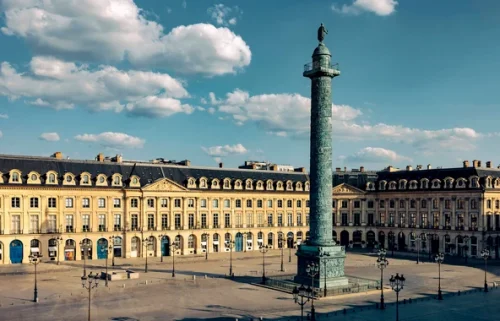
The resplendent service style is carefully nurtured and maintained: a finely dressed butler arriving at your door, silver tray in hand, to serve afternoon tea in the same fashion as it was presented to royalty centuries ago. The gleaming silver teapots, delicate china cups, and perfectly baked scones create a tableau of elegance.
Or imagine the discreet and attentive service of a personal valet, ensuring your every need is met with a grace that feels like stepping into a bygone era. These hotels preserve the art of hospitality, where every detail, from the monogrammed linens to the grand chandeliers, whispers stories of an age where luxury was defined by personalized, impeccable service.
Regal Retreats: Europe’s Grand Palace Hotels
In Europe, the blend of history and luxury finds a distinguished representation in the continent’s many palatial hotels.
The Ritz Paris, located in the heart of Paris on the Place Vendôme, has hosted famous names from Ernest Hemingway to Coco Chanel, each adding to its legendary status. The hotel’s recent restoration ensures that its timeless elegance remains untouched. Opened in 1898 by César Ritz, the Ritz Paris boasts sumptuous suites, including the famous Coco Chanel Suite, decorated with exquisite antiques and artworks. The hotel’s opulent interiors, featuring crystal chandeliers, gilded mouldings, and plush furnishings, reflect the grandeur of the Belle Époque era. Guests can enjoy world-class dining at the Michelin-starred restaurant L’Espadon, indulge in luxurious spa treatments, or sip cocktails at the iconic Bar Hemingway.
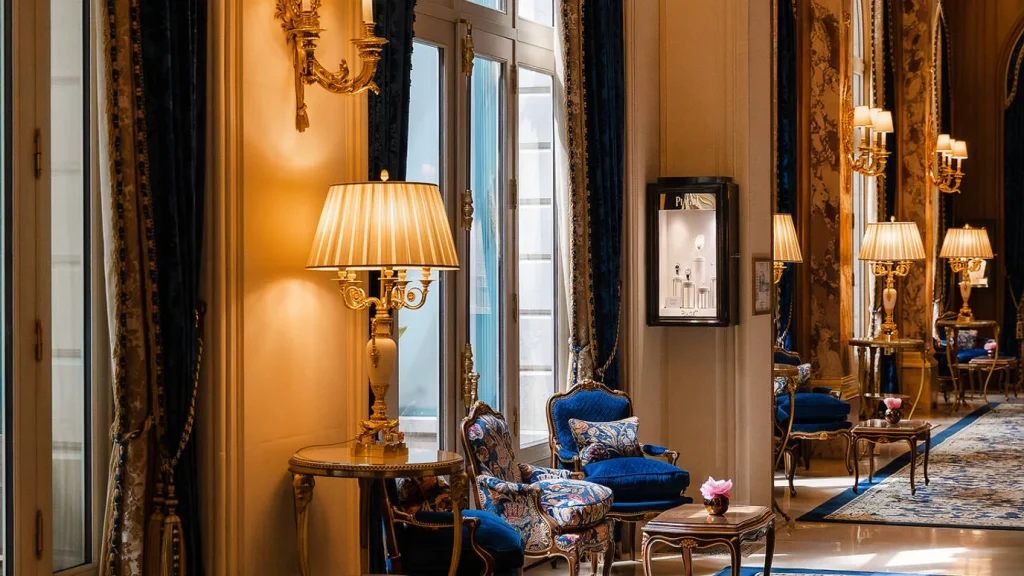
Venturing into the United Kingdom, The Savoy in London offers a similar blend of historic grandeur and contemporary luxury. Opened in 1889, The Savoy was the first luxury hotel in Britain to feature electric lights and elevators. Today, it continues to celebrate its rich history while offering state-of-the-art facilities to its guests, standing out as a must-visit landmark.
Claridge’s in London is a bastion of British elegance and luxury. Situated in the prestigious Mayfair district, this heritage hotel has been a favourite of royalty and celebrities since it opened in 1856. Claridge’s combines British aristocratic charm with modern sophistication, offering sumptuous rooms and suites decorated with art deco elements and bespoke furnishings. The hotel’s renowned afternoon tea, served in the elegant Foyer & Reading Room, is a quintessentially British experience. Guests can also enjoy fine dining at the Michelin-starred restaurant Davies and Brook or unwind at the chic Claridge’s Bar.
The Hotel Sacher in Vienna is an emblem of Austrian elegance and tradition. Established in 1876 by Eduard Sacher, son of the creator of the famous Sachertorte, this historic hotel has been a beacon of luxury and refinement. Located near the Vienna State Opera, the Hotel Sacher combines classic Viennese charm with modern amenities. Its lavish rooms and suites are adorned with antique furniture, rich fabrics, and original artwork. Guests can savour the legendary Sachertorte at the hotel’s Café Sacher or dine in style at the gourmet Restaurant Rote Bar.
Palazzo Versace in Milan is a testament to Italian fashion and luxury. Located in the fashion capital of the world, this grand palace hotel was designed by the legendary fashion house Versace. The hotel’s interiors are a stunning blend of classical architecture and contemporary design, featuring Versace’s signature opulence. Guests can indulge in lavish suites decorated with Versace’s iconic motifs, and enjoy gourmet Italian cuisine at the on-site restaurant.
Hotel de Paris in Monte Carlo is an icon of luxury and glamour. Established in 1864, this grand palace hotel is situated in the heart of Monaco, adjacent to the famous Casino de Monte-Carlo. The Hotel de Paris boasts lavishly decorated rooms and suites, offering stunning views of the Mediterranean Sea. Its opulent interiors feature marble columns, crystal chandeliers, and rich fabrics, reflecting the Belle Époque splendour. Guests can dine at the hotel’s renowned restaurant Le Louis XV – Alain Ducasse, which holds three Michelin stars, or relax at the luxurious Thermes Marins Monte-Carlo spa.
The Steigenberger Frankfurter Hof, an emblem of luxury and history, stands proudly in the heart of Frankfurt, Germany. Established in 1876, this grand hotel has long been a symbol of sophistication and elegance, welcoming royalty, dignitaries, and celebrities through its storied doors. The Frankfurter Hof blends classic architectural grandeur with modern comforts, featuring opulent interiors adorned with intricate detailing and plush furnishings. Guests can dine at the Michelin-starred Restaurant Français, or relax in the luxurious spa.
From Paris to Vienna, Milan to London, and Monte Carlo to Bavaria, Europe’s grand palace hotels are timeless havens of elegance and grandeur.
Asia’s Grand Heritage Palace Hotels
Moving to Asia, the continent’s history is rich with empires and dynasties, each leaving behind remnants of their grandeur in the form of palaces turned luxury hotels.
Raffles Hotel in Singapore is a symbol of colonial elegance and luxury. Established in 1887, this historic hotel has hosted numerous literary figures, celebrities, and royalty over the years. Its grand colonial architecture, featuring white façades, spacious verandahs, and lush tropical gardens, exudes a timeless charm. The interiors are equally opulent, with teakwood floors, lofty ceilings, and antique furnishings. Guests can enjoy the legendary Singapore Sling at the Long Bar or indulge in a lavish high tea at the Tiffin Room.
The Peninsula Hong Kong, often referred to as the “Grande Dame of the Far East,” opened its doors in 1928. This grand hotel is renowned for its blend of Eastern and Western influences, reflected in its majestic architecture and sophisticated interiors. The Peninsula boasts elegantly appointed rooms and suites, offering stunning views of Victoria Harbour.
Located on the iconic Bund in Shanghai, China, The Peace Hotel is a landmark of Art Deco architecture and luxury. Originally opened in 1929 as the Cathay Hotel, this historic property has been a symbol of glamour and sophistication for nearly a century. The hotel’s interiors feature lavish décor, with marble floors, grand chandeliers, and elegant furnishings. The Peace Hotel is famous for its Jazz Bar, where guests can enjoy live performances by the legendary Old Jazz Band. With its rich history and stunning views of the Huangpu River, The Peace Hotel offers a unique glimpse into Shanghai’s golden era.
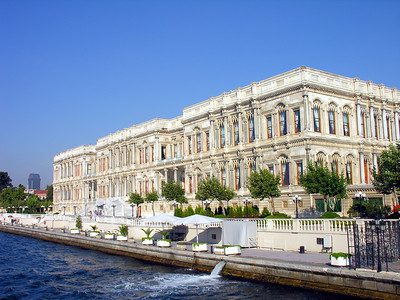
Perched on the shores of the Bosphorus, Çırağan Palace Kempinski in Istanbul is a stunning example of Ottoman grandeur. Originally built in the 19th century as a royal palace, this opulent hotel combines historical elegance with modern luxury. The palace’s architecture features intricate marble work, ornate ceilings, and grandiose halls, reflecting the splendour of the Ottoman Empire. Guests can enjoy panoramic views of the Bosphorus from the luxurious rooms and suites, dine at the award-winning Tugra Restaurant, or relax in the infinity pool overlooking the strait.
India’s Heritage Hotels: Echoes of Regal Splendour
India, often dubbed a land of myriad colours and narratives, offers some of the most exquisite palatial hotels that narrate stories of its regal past. These heritage properties are former palaces, forts, and mansions of India’s maharajas and are steeped in the country’s rich history and tradition.
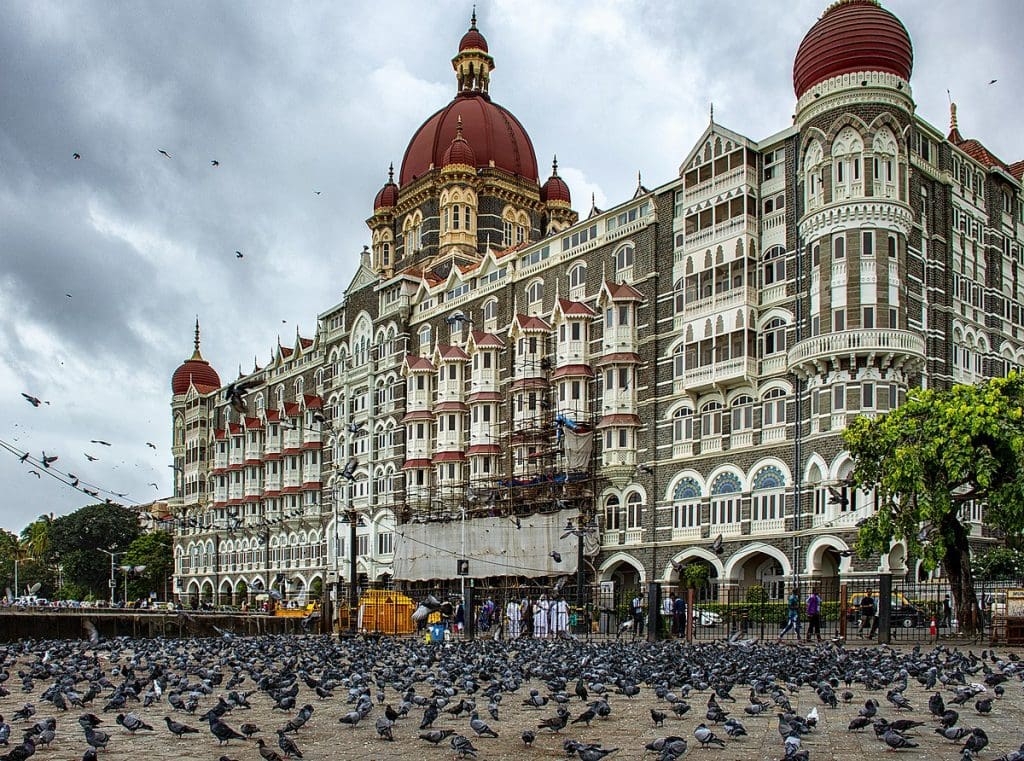
The Taj Mahal Palace in Mumbai is a striking example. This hotel has witnessed historical events that have shaped India. Its majestic architecture and prime location by the Arabian Sea have made it a favourite among dignitaries and celebrities alike. Opened in 1903, this historic hotel has become a landmark of Indian hospitality, blending Moorish, Oriental, and Florentine architectural styles. The hotel’s lavish interiors, adorned with hand-woven silk carpets, crystal chandeliers, and a grand marble staircase, reflect its grand heritage.
Built on an eight-acre estate, The Imperial New Delhi houses over 5,000 original artworks from the 17th and 18th centuries throughout its common areas and accommodations. Since opening in 1936, it has been the site of significant social gatherings, hosting royalty, celebrities, and dignitaries. Conceptualized by Blomfield and inaugurated by Lord Willingdon, the hotel’s iconic 24 royal palms mark the entrance, symbolizing the creation of New Delhi. The Imperial’s pillared verandahs, elegant dining rooms, famous tea lounge, Royal Ballroom, and lush gardens have hosted countless celebrations, making it a cornerstone of Delhi’s heritage.
One of the crown jewels among India’s luxury heritage stays is the Taj Lake Palace in Udaipur. Originally built in 1746 as the pleasure palace of Maharana Jagat Singh II, it appears to float miraculously on the serene waters of Lake Pichola. Today, it’s renowned for its unique setting, intricate architecture, and lavish hospitality that truly makes guests feel like royalty.
Nestled on the banks of Pichola Lake, stands the magnificent Shiv Niwas Palace owned by the royal HRH Group of Hotels, which also runs the Jagmandir Island Palace in Lake Pichola – an early 17th-century island palace. Originally constructed in the early 20th century during the reign of Maharana Fateh Singh, this crescent-shaped palace has been transformed into a luxurious heritage hotel. The interiors of Shiv Niwas Palace are adorned with ornate frescoes, antique furniture, and intricate glass mosaics, reflecting the rich cultural heritage of Rajasthan.
Another iconic establishment is the Rambagh Palace in Jaipur, which offers a taste of the royal lifestyle. This former residence of the Maharaja of Jaipur is famed for its exquisite gardens, elegant rooms, and marbled corridors. Built in 1835, Jaipur’s Rambagh Palace later became the residence of Maharaja Sawai Man Singh II and Maharani Gayatri Devi. Now a grandly restored Taj property, this 47-acre estate is known as the “Jewel of Jaipur.” The palace, with its Indo-Saracenic architecture, exemplifies Rajput traditions and heritage. It features hand-carved marble ‘jalis’, sandstone balustrades, cupolas, ‘chattris’, and royal Mughal gardens.
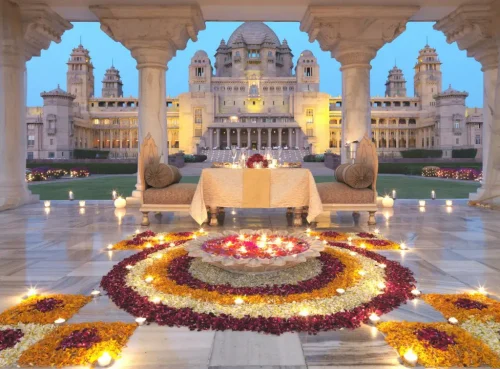
In Jodhpur, the Umaid Bhawan Palace divides its grandiose space between a royal residence and a heritage hotel managed by Taj Hotels. Constructed between 1928 and 1943, this golden-hued desert sandstone monument is one of the world’s largest private residences and displays a fusion of Indo-Saracenic, Classical Revival, and Western Art Deco elements. The palace complex spans 26 acres of land.
Heading south, the ‘Falaknuma Palace’ in Hyderabad, which means “Mirror of the Sky”, is perched 2,000 feet above the city. Originally the residence of the Nizam of Hyderabad considered the richest man in the world at one time, it has been restored by the Taj Group to offer a glimpse of the lavish lifestyle of the Nizams.
In Kerala, the enchantment of palatial stays continues with the likes of the Bolgatty Palace in Kochi. This exquisite property, originally built by Dutch traders in 1744 and later taken over by the British, is now a heritage hotel managed by the Kerala Tourism Development Corporation. Its luscious lawns, waterfront views, and historic ambience make it a preferred choice for those seeking tranquillity and a peek into colonial elegance.
Another gem is the Hill Palace in Thripunithura, the largest archaeological museum in Kerala, which showcases the royal heritage of the Maharajas of Kochi. Though not a hotel, its sprawling grounds and well-preserved artefacts provide a cultural backdrop that complements the luxurious stays in nearby heritage hotels.
These palaces, whether functioning as hotels or museums are a window into the lavish, intricate lifestyle of India’s royal past.
North and South America’s Timeless Treasures
Across the Atlantic, American historic hotels tell newer, yet equally compelling stories. The ‘Waldorf Astoria’ in New York City, established in the 1890s and rebuilt in 1931, mirrors the ambition and glamour of the city. Known for its Art Deco interiors and impeccable service, the Waldorf Astoria has been a symbol of high society’s social gatherings and significant political meetings.
Further south, in Cuba, the Hotel Nacional de Cuba in Havana offers a peek into Cuba’s dynamic history. Since its opening in 1930, it has been a witness to the island’s tumultuous history, hosting world leaders and global superstars. The hotel’s vintage charm is a time capsule of the 1930s, offering a unique perspective on Cuban history.
In South America, the allure of historic palace hotels offers a similarly enchanting experience. From the opulent splendour of Palacio Duhau in Buenos Aires, with its elegant gardens and regal architecture, to the majestic Belmond Copacabana Palace in Rio de Janeiro, these establishments encapsulate the rich cultural tapestry and grand history of the region.
Guests are treated to an experience that blends colonial charm with modern sophistication. Imagine enjoying a leisurely breakfast on a sunlit terrace, surrounded by lush tropical gardens, or being attended to by staff trained in the traditions of old-world service.
Regal Retreats: Heritage Palace Hotels in Africa
Africa’s rich history and diverse cultures are beautifully reflected in its iconic heritage palace hotels. These luxurious establishments allow guests to experience the grandeur and elegance of bygone eras.
Nestled at the foot of Table Mountain, the Mount Nelson Hotel, in South Africa often referred to as “The Nellie,” is a pink palace steeped in history. Opened in 1899, this iconic hotel has hosted numerous celebrities, politicians, and royalty. Its colonial architecture, lush gardens, and remarkable interiors reflect a blend of Victorian elegance and contemporary luxury.
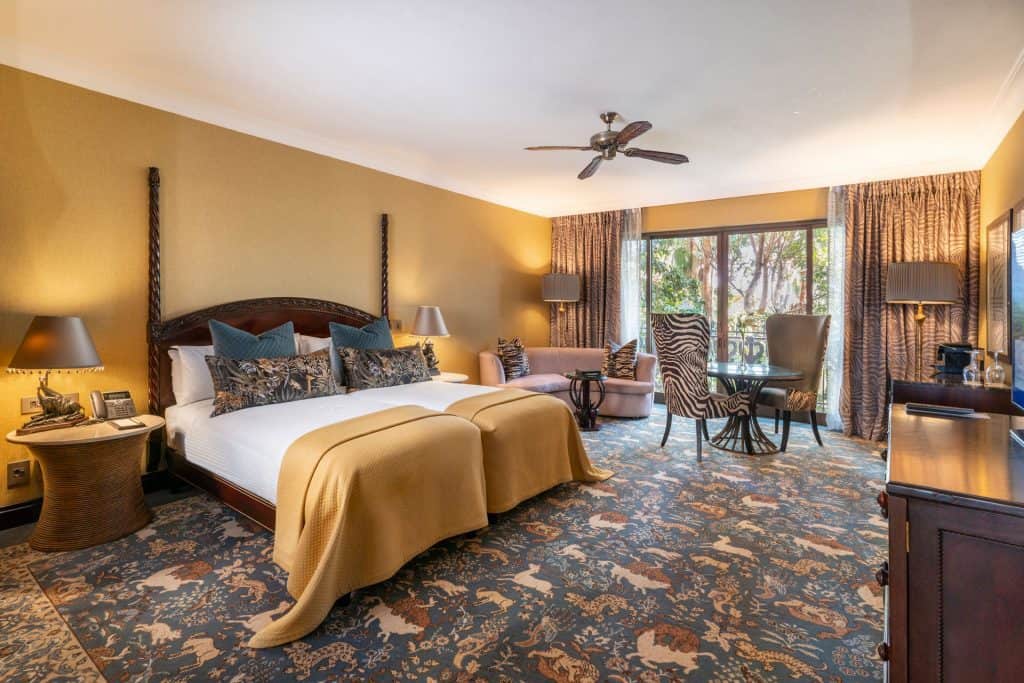
The Palace of the Lost City in Sun City, South Africa, deserves mention for its extraordinary grandeur and architectural brilliance. Inspired by a mythical African kingdom, this palace hotel features opulent interiors, lush gardens, and breathtaking views of the Pilanesberg Mountains. Guests can enjoy luxurious accommodations, world-class dining, and a range of recreational activities, from golf to safari adventures.
La Mamounia in Morocco is a legendary palace hotel that has enchanted visitors since it opened its doors in 1923. Located in the heart of Marrakech, this hotel is a masterpiece of Moroccan architecture and design. Its lavish interiors are adorned with intricate mosaics, carved woodwork, and plush fabrics. The hotel is surrounded by beautifully landscaped gardens that date back to the 18th century, offering a peaceful retreat to countless dignitaries and celebrities.
Owned by Sir Richard Branson, Kasbah Tamadot in Morocco is a stunning palace hotel located in the Atlas Mountains. This exquisite retreat, once the private home of an Italian antique dealer, is a blend of traditional Moroccan architecture and contemporary luxury. Each room is uniquely decorated with artefacts from around the world, creating a serene and luxurious ambience.
Perched on the banks of the Zambezi River, just a stone’s throw away from the magnificent Victoria Falls, the Royal Livingstone Hotel in Zambia is a testament to colonial elegance. Named after the famous explorer David Livingstone, this hotel combines Edwardian-style architecture with African-inspired decor. Guests can savour gourmet meals on the terrace with views of the river or enjoy a sunset cruise on the Zambezi. The hotel’s proximity to one of the natural wonders of the world adds to its allure, providing a unique blend of adventure and luxury.
As Nairobi’s first luxury hotel, the Sarova Stanley has been a landmark of sophistication since 1902. This historic hotel has retained its colonial charm while offering modern amenities. Its grand lobby, adorned with vintage photographs and period furnishings, transports guests back to the early 20th century. The famous Thorn Tree Café, once a meeting point for explorers and travellers, continues to be a popular spot.
These iconic heritage palace hotels in Africa are nestled in bustling cities, serene mountains, or majestic rivers, and invite guests to indulge in the regal splendour of Africa’s heritage.
The Middle Eastern Heritage Legacy Hotels
The Middle East, with its ancient civilizations, also hosts several palatial hotels that offer a glimpse into its rich past. The Middle East, a region steeped in history and cultural richness, boasts some of the most opulent and historically significant heritage hotels in the world. These hotels serve as living museums, showcasing the architectural brilliance and grandeur of bygone eras.
Located in the shadow of the Great Pyramids of Giza, Mena House in Cairo run by Marriott is a historic palace hotel that exudes timeless elegance and grandeur. Originally built in 1869 as a hunting lodge for Egypt’s Khedive Ismail, it was transformed into a luxury hotel that has hosted royalty, dignitaries, and celebrities for over a century. The hotel’s lavish interiors, featuring Moorish architecture, ornate wooden panelling, and intricate arabesque designs, reflect its rich history and cultural heritage.
Nestled between the rugged Al Hajar Mountains and the sparkling Sea of Oman, Al Bustan Palace is a testament to Omani elegance and hospitality. Originally built to host the Gulf Cooperation Council summit in 1985, this majestic hotel reflects a blend of traditional Omani architecture and contemporary luxury. The hotel’s grand atrium, with its soaring 38-meter-high domed ceiling, intricate carvings, and lavish chandeliers, sets the tone for an opulent stay.
Emirates Palace in Abu Dhabi is a modern-day palace that exudes Arabian opulence and grandeur. Opened in 2005, this architectural marvel was designed to showcase the very best of Arabian culture and hospitality. The hotel run by Mandarin Oriental features 114 domes, each adorned with gold leaf, marble, and mother-of-pearl detailing. Its interiors are equally lavish, with intricate mosaics, plush furnishings, and state-of-the-art amenities. The Emirates Palace offers guests a royal experience with its private marina, pristine beaches, and exquisite dining options.
The King David Hotel in Jerusalem is a historic landmark that has hosted royalty, dignitaries, and celebrities since it opened in 1931. Overlooking the Old City of Jerusalem, this hotel combines classic elegance with modern sophistication. Its stone façade, grand public spaces, and lush gardens reflect the heritage and history of the region. The King David Hotel is renowned for its impeccable service and luxurious accommodations, offering guests a unique blend of historical charm and contemporary comfort. Its location provides stunning views of Jerusalem’s ancient landmarks, adding to its allure.
While straddling the border of North Africa and the Middle East, the Taj Palace in Marrakech deserves mention for its blend of Middle Eastern and Moroccan heritage. This palatial hotel is set against the backdrop of the Atlas Mountains and features architecture inspired by Arabian, Moorish, and Indian styles. The hotel’s grand courtyards, intricate mosaics, and opulent interiors transport guests to a world of timeless elegance.
Situated in the vibrant city of Istanbul, the Pera Palace Hotel is a beacon of European and Ottoman luxury. Established in 1895 to accommodate passengers of the famed Orient Express, the hotel has maintained its historical charm while incorporating modern amenities. The Pera Palace Hotel is renowned for its elegant décor, featuring original furnishings, vintage photographs, and a collection of artefacts that tell the story of Istanbul’s rich past. Guests can enjoy traditional Turkish tea in the opulent Kubbeli Lounge or explore the bustling streets of the historic Pera district.
These Middle Eastern heritage legacy hotels offer guests a unique opportunity to experience the rich cultural heritage and architectural splendour of the region.
A Passage to the Past
Staying in these historic luxury hotels is more than a night’s stay; it is an immersive experience into the depths of a locale’s culture, history, and soul. Each hotel, with its unique narrative and preserved heritage, offers an enriching journey not just into the comforts of luxury but into the very spirit of the place it belongs to. For the discerning traveller, these hotels are destinations in their own right, promising memories that are as grand as their storied halls.
Read More: Latest



